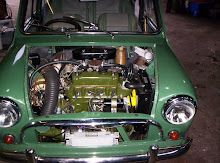We can now turn to an assessment of the road manners and handling characteristics of the cars or vans, mainly for the benefit of a driver who has no previous experience of these models and therefore lacks a yardstick by which to judge the performance of a particular car perhaps a used example that he has just purchased or is intending to put through a fairly comprehensive road test.
The points that will be emphasized are those that will give a fairly reliable indication of its general mechanical condition. It is impossible, of course, to lay down hard-and-fast standards, as so much will depend on the mileage that has been covered since new or since an overhaul was carried out. A certain amount of latitude must therefore be allowed, but it should also be remembered that, initially, these cars set a very high standard and will amply repay any work put in by a keen and conscientious owner.
The engine should be smooth and quiet, apart from a certain amount of "buzz" from the cooling fan as the speed rises, and a noticeable but not un¬pleasant whine from the constant-mesh gears that convey the drive from the engine to the gearbox, which are always in action, even when top gear is engaged (for details of a really worthwhile sound-damping kit, see Chapter 12).
Drivers of earlier models often criticized the gearchange on the score of stiffness in action, particularly "across the gate" between second and third gears. This tended to wear off, or at least become less noticeable, as the mileage mounted, and the change was, in addition, noticeably improved on later cars. As with many popular cars, difficulty is sometimes experi¬enced in engaging first gear when the car is at rest and as this gear is not synchronized on earlier cars, the double-declutching technique must be used when changing from second to bottom gear with the car on the move. In other words, the clutch must be momentarily engaged when the gear lever has been slipped into neutral, the engine at the same time being accelerated to synchronize the gears; the clutch is then depressed and the gear lever moved into the first-gear position.
The experienced driver will probably double-declutch even when changing between the upper ratios, since the synchromesh is not very powerful and can be overcome even when making moderately slow changes.
The baulk-ring synchromesh gearbox fitted to later models, however, was a great improvement and eliminated most of the complaints associated with earlier cars. Modifications to the remote-control gearchange on earlier Cooper models also cured the irritating rattle that developed at certain engine speeds, but as the nylon cup incorporated in the ball-and-
Fig. 5. The Austin Mini Countryman Mark II, counterpart of the Morris Mini Traveller
socket of the lever on later cars wears, the rattle can recur. The simple cure is to remove the gear lever and fit a second spring inside the existing spring. This will make gearchanging a little stiffer but will save a great deal of wear and tear on the driver's nerves!
While on the subject of troubles which develop in early Minis, the tendency to frequent breakage of the exhaust pipe cannot be overlooked. Owing to the design of the exhaust system, the pipe absorbs a considerable amount of the engine torque reaction, as the engine attempts to rock on its mountings. An engine tie-bar is fitted but when the bushes become worn the exhaust pipe eventually fractures, either at the manifold joint or at the bracket at the gearbox.
On pre-1964 cars, the remedy is to fit pairs of special cones, which are obtainable from most accessory shops stocking Mini gadgets, to the tie-bar bushes. The trouble is not likely to occur on later cars nor was it experienced on Cooper models, which have different mounting arrangements.
Finally, if you have an early model which is not fitted with the sixteen-blade fan, a lot of engine noise can be eliminated by substituting the latest pattern. It costs about £1, but you will have to remove the radiator in order to fit it.



0 comments:
Post a Comment